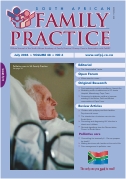Post-marketing stability surveillance: Amoxicillin
Abstract
Background To ensure the successful treatment of infectious disease using antimicrobial therapy, a sufficient concentration of the stable, active drug is required at the site of infection. For the achievement of this with respect to the ß-lactam group of antibiotics, of which amoxicillin is a member, the presence of an intact ß-lactam ring is essential. Destruction of this sensitive ring can lead to the ingestion of an inactive drug. This can contribute to treatment failure and antibiotic resistance. Thus, the aims of this study were to determine whether the types of packaging in which amoxicillin preparations are dispensed and the temperature and humidity conditions under which they are stored by patients are adequate and appropriate to ensure drug stability. Methods A mini-survey of pharmacies and patients was conducted in order to determine the types of packaging in which amoxicillin preparations are dispensed and the temperature and humidity conditions under which they are stored by patients. The amoxicillin preparations in the identified types of packaging were subjected to simulated conditions that represented the identified temperature and humidity stresses that occurred under patient storage conditions for a duration of 14 days. The extent of breakage of the ß-lactam ring was then chemically determined on day 1, day 7 and day 14, using an iodometric titration method. Results The mini-survey identified four types of packaging in which amoxicillin capsules are dispensed – plastic packets, flip-top amber bottles, flip-top amber bottles with cotton wool and flip-top transparent bottles with cotton wool. The laboratory analyses showed that only those amoxicillin capsules stored between 20 and 25 0C and protected from moisture were stable in all four identified types of packaging for 14 days. The mini-survey also indicated that 47% of the patient sample did not store their antibiotic suspensions in the refrigerator. The laboratory analyses showed that only amoxicillin suspensions stored between 2 and 8 0C for seven days showed the lowest level of degradation. Conclusion The results of this study indicate that reconstituted amoxicillin suspensions should be stored in the temperature range 2 to 8 0C, and that the reconstitution and dispensing of a 14-day supply of amoxicillin suspensions should be discouraged, even if the drug is stored in this temperature range. For amoxicillin capsules, the results obtained in this study indicate that significant breakage of the ß-lactam ring of amoxicillin capsules can occur in hot and humid climatic conditions if inadequate types of packaging are used and storage occurs under inappropriate conditions. The results of the study point to the importance of drug stability knowledge as a prerequisite for the dispensing of medicines, the importance of the provision of patient counselling with regard to drug storage requirements, as well as a requirement for amoxicillin capsules to be dispensed in the original manufacturers’ containers in geographical areas that are hot and humid. SA Fam Pract 2006;48(6): 14)
Issue
Section
Original Research
By submitting manuscripts to SAFP, authors of original articles are assigning copyright to the South African Academy of Family Physicians. Copyright of review articles are assigned to the Publisher, Medpharm Publications (Pty) Ltd, unless otherwise specified. Authors may use their own work after publication without written permission, provided they acknowledge the original source. Individuals and academic institutions may freely copy and distribute articles published in SAFP for educational and research purposes without obtaining permission.

